Stefan Großkopf
Detection and Visualization of Endoleaks in CT Data for Monitoring of Thoracic and Abdominal Aortic Aneurysm Stents
Feb 09, 2016Abstract:In this paper we present an efficient algorithm for the segmentation of the inner and outer boundary of thoratic and abdominal aortic aneurysms (TAA & AAA) in computed tomography angiography (CTA) acquisitions. The aneurysm segmentation includes two steps: first, the inner boundary is segmented based on a grey level model with two thresholds; then, an adapted active contour model approach is applied to the more complicated outer boundary segmentation, with its initialization based on the available inner boundary segmentation. An opacity image, which aims at enhancing important features while reducing spurious structures, is calculated from the CTA images and employed to guide the deformation of the model. In addition, the active contour model is extended by a constraint force that prevents intersections of the inner and outer boundary and keeps the outer boundary at a distance, given by the thrombus thickness, to the inner boundary. Based upon the segmentation results, we can measure the aneurysm size at each centerline point on the centerline orthogonal multiplanar reformatting (MPR) plane. Furthermore, a 3D TAA or AAA model is reconstructed from the set of segmented contours, and the presence of endoleaks is detected and highlighted. The implemented method has been evaluated on nine clinical CTA data sets with variations in anatomy and location of the pathology and has shown promising results.
Determination, Calculation and Representation of the Upper and Lower Sealing Zones During Virtual Stenting of Aneurysms
Oct 21, 2013

Abstract:In this contribution, a novel method for stent simulation in preoperative computed tomography angiography (CTA) acquisitions of patients is presented where the sealing zones are automatically calculated and visualized. The method is eligible for non-bifurcated and bifurcated stents (Y-stents). Results of the proposed stent simulation with an automatic calculation of the sealing zones for specific diseases (abdominal aortic aneurysms (AAA), thoracic aortic aneurysms (TAA), iliac aneurysms) are presented. The contribution is organized as follows. Section 2 presents the proposed approach. In Section 3, experimental results are discussed. Section 4 concludes the contribution and outlines areas for future work.
* 4 pages, 2 figures, 10 references
 Add to Chrome
Add to Chrome Add to Firefox
Add to Firefox Add to Edge
Add to Edge